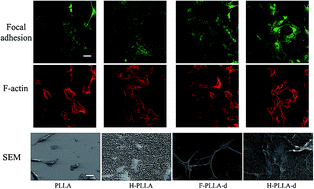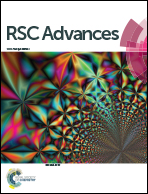Combination of positive charges and honeycomb pores to promote MC3T3-E1 cell behaviour
Abstract
A facile chemistry route to prepare symmetric poly(L-lactide) (PLLA)-based dendritic L-lysine copolymer (PLLA-d), with a PLLA block as the core and lysine dendrons in the two ends to provide certain density of positive charges, through a divergent method is reported. The polymers were characterized by 1H NMR, GPC and MALDI-TOF to confirm the well-defined chemical architecture. The study on crystallization behaviour demonstrated that the introduction of the lysine dendron favoured the formation of banded spherulites when compared with the PLLA polymer. The differential scanning calorimetry (DSC) results showed that the lysine dendron disrupted PLLA crystalline region and lowered the melting point and crystallinity of PLLA. The PLLA-d was fabricated into honeycomb films (H-PLLA-d) through the breath-figure method for water contact angle test and in vitro study, with flat PLLA, honeycomb PLLA, and flat PLLA-d films (PLLA, H-PLLA, and F-PLLA-d, respectively) as the controls. The water contact angle test indicated that the hydrophilicity of the PLLA-d film was strongly improved after the incorporation of the lysine dendron into PLLA. The incorporation of the lysine dendron increased the surface zeta potential and decreased the mechanical properties of PLLA. Mouse osteoblastic cell (MC3T3-E1) functions including cell attachment, adhesion, proliferation, and differentiation were investigated on PLLA, H-PLLA, F-PLLA-d and H-PLLA-d films. The results indicated that MC3T3-E1 cell functions were significantly enhanced on F-PLLA-d or H-PLLA films and especially H-PLLA-d ones. This study not only demonstrates a facile approach to fabricate a novel copolymer film (H-PLLA-d), which combines positive charges with honeycomb pores, but also provides a potential biomaterial for bone repair by improving osteoblastic cell functions.


 Please wait while we load your content...
Please wait while we load your content...